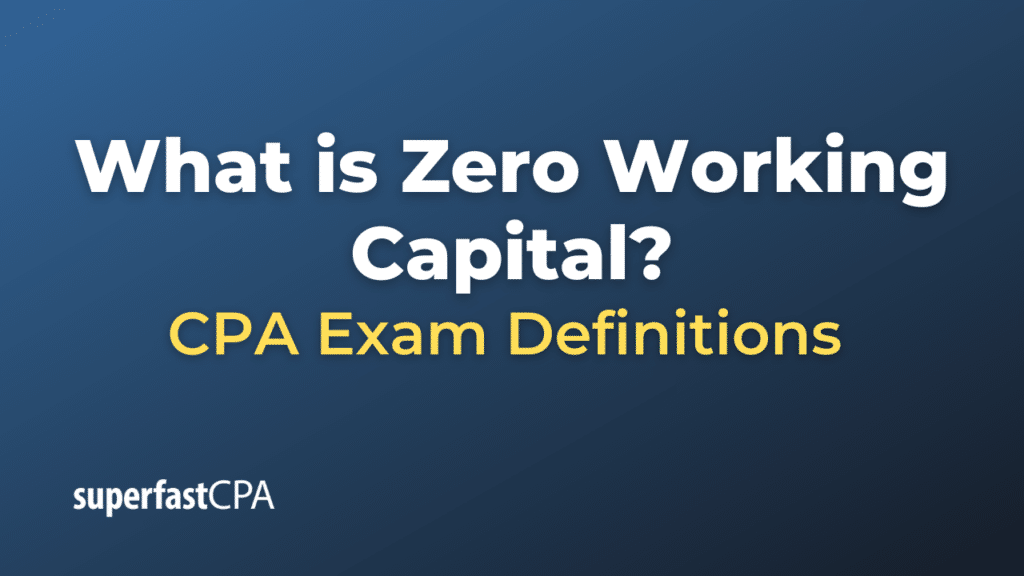Zero Working Capital
Zero Working Capital is a financial strategy where a company aims to operate with minimal levels of working capital. In accounting terms, working capital is the difference between a company’s current assets and current liabilities. Current assets include items like cash, accounts receivable, and inventory, while current liabilities include accounts payable and other short-term debts.
The idea behind Zero Working Capital is to minimize the amount of funds tied up in current assets such as inventory and accounts receivable, while maximizing the benefits from current liabilities like accounts payable. In essence, it’s an approach that seeks to finance short-term operational needs through short-term obligations, rather than relying on internal funds.
Advantages of Zero Working Capital:
- Improved Cash Flow: By minimizing funds tied up in inventory and speeding up accounts receivable, more cash is available for investment or other uses.
- Efficiency: This strategy encourages better management of assets and liabilities, which can improve overall efficiency and profitability.
- Reduced Costs: Holding less inventory reduces storage costs and the risk of obsolescence. Also, by efficiently timing accounts payable, companies can take advantage of discounts or favorable payment terms.
Disadvantages of Zero Working Capital:
- Increased Risk: Operating with low levels of working capital may expose the company to liquidity issues, especially if it faces unexpected expenses or drops in revenue.
- Supplier Relationships: Stretching accounts payable may strain relationships with suppliers, which could result in less favorable terms in the future.
- Operational Challenges: Achieving a Zero Working Capital strategy requires tight management of all elements of working capital, which can be operationally challenging and might distract from other business activities.
Example of Zero Working Capital
Let’s look at a simplified example of a fictional manufacturing company named “QuickMachines Inc.” to illustrate the concept of Zero Working Capital.
Initial Scenario:
- Current Assets:
- Cash: $100,000
- Accounts Receivable: $80,000
- Inventory: $50,000
- Current Liabilities:
- Accounts Payable: $70,000
- Other Short-Term Debt: $30,000
- Working Capital: Current Assets ($100,000 Cash + $80,000 Accounts Receivable + $50,000 Inventory = $230,000) – Current Liabilities ($70,000 Accounts Payable + $30,000 Other Short-Term Debt = $100,000) = $130,000
Steps to Achieve Zero Working Capital:
- Just-In-Time Inventory: QuickMachines switches to a just-in-time inventory system, reducing its average inventory level from $50,000 to $20,000.
- Speed Up Accounts Receivable: The company tightens its credit policy and offers discounts for quick payments, reducing accounts receivable from $80,000 to $60,000.
- Extend Accounts Payable: It negotiates with suppliers to extend the payment terms from 30 days to 45 days, increasing accounts payable from $70,000 to $90,000.
Resulting Scenario:
- New Current Assets:
- Cash: $100,000 (unchanged)
- Accounts Receivable: $60,000 (reduced)
- Inventory: $20,000 (reduced)
- New Current Liabilities:
- Accounts Payable: $90,000 (increased)
- Other Short-Term Debt: $30,000 (unchanged)
- New Working Capital: Current Assets ($100,000 Cash + $60,000 Accounts Receivable + $20,000 Inventory = $180,000) – Current Liabilities ($90,000 Accounts Payable + $30,000 Other Short-Term Debt = $120,000) = $60,000
Observations:
- Working Capital has been significantly reduced from $130,000 to $60,000, moving closer to a Zero Working Capital position.
- By minimizing the funds tied up in inventory and accounts receivable, and maximizing accounts payable, the company has freed up cash, which it can use for other productive activities or investments.
- The company achieved this while maintaining its level of operations and without compromising its ability to meet short-term obligations.
While this is a simplified example, it should give you an idea of how a Zero Working Capital strategy might be implemented in a real-world scenario. The goal is to improve cash flow and operational efficiency by closely managing current assets and liabilities.













